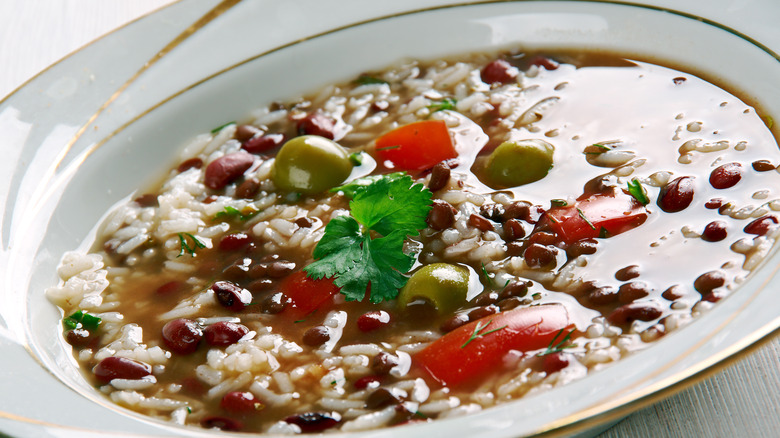Puerto Rico's National Soup Has A Rich History
A national dish represents a country's cultural identity, culinary ecology, and complex history, while also remaining a beloved household or restaurant staple. Puerto Rico's national soup, asopao, is rooted in the turbulent history of its colonization, and its multicultural and multi-racial identity, encompassing a wide range of recipes locals enjoy.
Asopao is a soup that sometimes comes out more like a stew, and is usually made with a brothy rice base seasoned with sofrito, tomato sauce, peppers, and herbs, and filled with any number of proteins or vegetables. While asopao didn't show up on restaurant menus until the 1800s, the recipe itself dates back to Spanish colonization and the African slave trade. Puerto Rican heritage and culinary traditions are often derived from a mix of Spanish and African influences. As such, local food historians assert that asopao is a cross between saffron rice and gumbo, using the local Caribbean bounty to supply its own flavors and ingredients.
The most popular version of the dish is asopao de pollo, made with stewed chicken and rice in a tomato, pepper, and sofrito-infused broth. Other versions include asopao de mariscos, a Puerto Rican twist on seafood gumbo with the same brothy rice foundation, and asopao de gandules that uses pigeon peas instead of or in addition to rice, as well as stewed oxtail or pork.
Asopao: How and where to enjoy it
Not only do numerous types of asopao exist according to regional ingredient availability, but each household reveres its own intergenerational recipe. The versatility, adaptability, and everyman appeal of asopao makes it a beloved dish throughout Puerto Rico. Every home cook and restaurant chef has the freedom to customize and season their dish as they see fit, with no specific recipe reigning supreme. Some asopao dishes are soupier while others have more of a risotto-like consistency.
As a hot dish loaded with spices, dumplings, rice, and different types of meat and seafood, asopao is a comfort food often made during the winter months or on rainy days. It's also lauded as a classic cure-all, similar to chicken soup, warming up a pesky cold or absorbing the previous night's hangover. You'll often see asopao served during Christmas, New Year's, or Día de Reyes celebrations. Common garnishes include smoked meats, olives, capers, avocado slices, and peas. Many restaurants and households around Puerto Rico serve a steaming pot of asopao with tostones or thick slices of bread to sop up all the flavorful broth-saturated rice.

